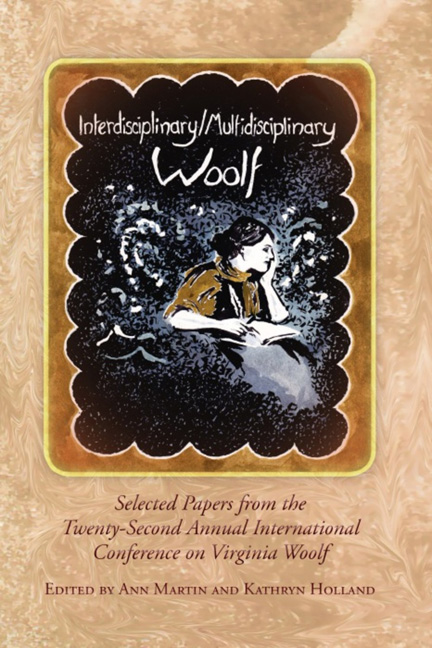Book contents
- Frontmatter
- Contents
- Introduction to Interdisciplinary/Multidisciplinary Woolf
- Acknowledgments
- List of Abbreviations
- History, Materiality, Multiplicity
- Patterns, Practices, Principles
- Art, Influence, Embodiment
- “Time has whizzed back an inch or two on its reel”: Relating Virginia Woolf and Emily Carr through Vintage Postcards, Lily Broscoe, Mrs. McNab, and the Cinematic Time of To the Lighthouse
- Speaking Citizen to Citizen in a Time of War: Miss La Trobe's Use of Parabasis in her Historical Pageant
- Work as Salvation: Eureka's Angel in the House, A Dircetor's Experience
- Drawing as Thinking: A Visual Response to To the Lighthouse
- Performing Feminism, Transmitting Affect: Isadora Duncan, Virginia Woolf, and the Politics of Movement
- Virginia Woolf and Clarice Lispector: Thinking Back Through Brazilian Mothers
- Mystical Gibberish or Renegade Discourse?: Poetic Language According to Orlando
- Selves and Others as Narrative Participants in Woolf's Novels
- Publishing, Politics, Publics
- Notes on Contributors
- Conference Program
Drawing as Thinking: A Visual Response to To the Lighthouse
from Art, Influence, Embodiment
- Frontmatter
- Contents
- Introduction to Interdisciplinary/Multidisciplinary Woolf
- Acknowledgments
- List of Abbreviations
- History, Materiality, Multiplicity
- Patterns, Practices, Principles
- Art, Influence, Embodiment
- “Time has whizzed back an inch or two on its reel”: Relating Virginia Woolf and Emily Carr through Vintage Postcards, Lily Broscoe, Mrs. McNab, and the Cinematic Time of To the Lighthouse
- Speaking Citizen to Citizen in a Time of War: Miss La Trobe's Use of Parabasis in her Historical Pageant
- Work as Salvation: Eureka's Angel in the House, A Dircetor's Experience
- Drawing as Thinking: A Visual Response to To the Lighthouse
- Performing Feminism, Transmitting Affect: Isadora Duncan, Virginia Woolf, and the Politics of Movement
- Virginia Woolf and Clarice Lispector: Thinking Back Through Brazilian Mothers
- Mystical Gibberish or Renegade Discourse?: Poetic Language According to Orlando
- Selves and Others as Narrative Participants in Woolf's Novels
- Publishing, Politics, Publics
- Notes on Contributors
- Conference Program
Summary
Virginia Woolf's novel To the Lighthouse was my starting point for a series of drawings on paper. The drawings, and their relation to the novel, raise questions about the connections between writing and drawing – text and mark. I argue that both drawing and reading can be creative, even playful, activities that enable spontaneity and continuing dialogue. The Lighthouse drawings are inspired by my readings of To the Lighthouse and informed by some of Woolf's other writings. In making these drawings I have explored how drawing and reading are both active practices, and how the practice of one can benefit the other. I suggest that drawing is a fundamentally exploratory and open-ended process. Through drawing and reading I have entered into a dialogue with the book object.
This project—to make a reading of To the Lighthouse through drawing—extends to a broader interest in the connections between text and mark-making. I suggest a correspondence between the fluidity of Mrs. Ramsay's experience of reading in To the Lighthouse, and ideas of indeterminacy and open-ended exploration in drawing practice. Conversational drawing, for example, is a technique that encourages a collaborative approach to mark-making. This idea of drawing as an exploratory process resonates with my reading of To the Lighthouse.
Drawing is visual thinking. Reading too engenders thinking, if it is done effectively. The process of making the Lighthouse drawings was a way of actively engaging with the text, furthering my understanding, and confronting my uncertainties. In making drawings as a response to To the Lighthouse, I attempted to unravel the dynamic between book and reader, and present this relationship in material form.
To the Lighthouse can be read as an exploration of two opposing ways of thinking, and of how these contrasting mind-sets coexist and communicate with one other. From the start of the novel—where Mrs. Ramsay and James's thoughts thread between each other, disrupted only by Mr. Ramsay's need for attention—Woolf presents a collage of perspectives, as conscious beings communicate silently, sympathetically, or at cross purposes. Mr. and Mrs. Ramsay have, throughout the novel, moments of intense, unspoken communication. This takes on a heightened form when Mrs. Ramsay comes to sit with her husband after dinner.
- Type
- Chapter
- Information
- Interdisciplinary/Multidisciplinary Woolf , pp. 177 - 182Publisher: Liverpool University PressPrint publication year: 2013



